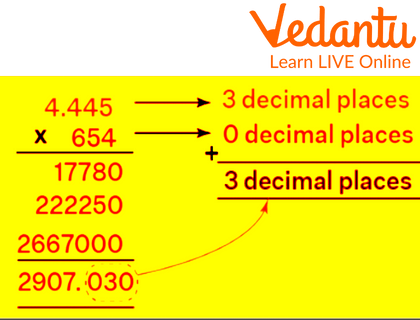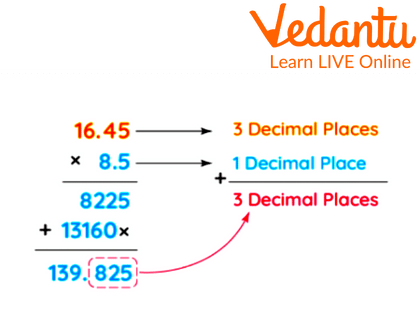




Simple Rules for Multiplying Decimals and Whole Numbers Explained
Brief about How to Multiply Decimals with Whole Numbers Step by Step
Decimal multiplication is crucial when discussing the grouping of elements. Let's say there are 12 kids in all, and you have to give each one 0.25 parts of a chocolate bar. How many bars of chocolate would you require? We need to multiply 12 by 0.25 to get the required amount of chocolate bars. When multiplying decimals, one must first multiply the integers without considering the decimal point, followed by the number of decimals.
Whole Numbers
The term "whole numbers" refers to numbers which are devoid of fractions and are made up of positive integers and zero. It is denoted by the letter "W," and its corresponding set of numbers are “0, 1, 2, 3, 4, 5, 6, 7,…”The entire number zero denotes nothing or a null value.
Decimal Numbers
One type of number that has a whole number and a fractional component separated by a decimal point is a decimal. A decimal point is a dot that appears between parts of a whole number and a fraction. An example of a decimal number is 24.5.
How to Multiply a Decimal with Whole Numbers Step by Step
The fundamental distinction between multiplying decimals by whole numbers and multiplying whole numbers is where the decimal point is placed. Let's examine the procedures listed below to comprehend the division of a decimal by a whole number.
Step 1: Multiply the integers using the standard approach, initially ignoring the decimal point.
Step 2: Count the number of decimal places in the given integers after the multiplication.
Step 3: The number of decimal places in the result of the multiplication should match the number provided in the numbers. In other words, the decimal point in the product should be positioned so that it equals the total of all the multiplicand and multiplier decimal places.
Key Points to Remember
These are a few essential ideas on the idea of dividing decimals by whole numbers:
The same guidelines apply when multiplying a decimal by a whole number as when multiplying whole integers.
The decimal point in the product should be positioned so that it equals the total of all the multiplicand and multiplier decimal places.
When adding the decimal point, all of the product's zeros must remain.
Before inserting the decimal point, zeros can be added to the left if the product has more decimal places than the number of digits.
The final product's trailing zeros can be removed.
Conclusion
One of the crucial applications is multiplying a decimal by a whole number when billing for things where the amount is frequently expressed in decimals. We need decimals in our daily life. The majorities of their applications are in industries like measurement and finance where precise computations are required.
Solved Examples
Example 1: Salina is attempting to calculate the product of two numbers, 654 and 4.445. Can you help her in doing the multiplication?
Ans: We can see that the numbers are 654 and 4.445, which are decimals and whole numbers, respectively.
We will thus use the procedures for multiplying a decimal by a whole number in order to obtain the product of these two values.

Multiplication of 4.445 and 654
Therefore, 4.445 multiplied by 654 results in 2907.03
Example 2: If Raj got 88.63 marks in English, Math and Hindi. Then how many marks did Raj get in these three subjects? (Use multiplication)
Ans: Given that Raj got 88.63 marks in 3 subjects.
Thus, his marks in total in these 3 subjects would be \[88.63 \times 3 = 265.89\]
Total marks he got is 265.89.
Example 3: Find the product of 16.45 and 8.5.
Ans:

Multiplication of 16.45 and 8.5
FAQs on How to Multiply Decimals by Whole Numbers (with Examples)
1. What are the basic steps to multiply a decimal by a whole number?
To multiply a decimal by a whole number, follow these three simple steps: First, ignore the decimal point and multiply the two numbers as if they were both whole numbers. Second, count the total number of digits after the decimal point in the original decimal number. Finally, place the decimal point in your result (the product) so that it has the same number of decimal places you counted in the previous step.
2. Can you provide an example of multiplying a decimal by a whole number, like 3.12 x 4?
Certainly. Let's multiply 3.12 by 4:
- Step 1: Multiply without decimals. Ignore the decimal point and calculate 312 × 4, which equals 1248.
- Step 2: Count decimal places. The number 3.12 has two digits after the decimal point.
- Step 3: Place the decimal point. In the product 1248, start from the right and count two places to the left to place the decimal point. This gives you 12.48.
So, 3.12 × 4 = 12.48.
3. Do I need to line up the decimal points when setting up the multiplication problem?
No, you do not need to line up the decimal points. That rule is for adding and subtracting decimals. For multiplication, you should align the numbers based on their last digit (to the right), just as you would with whole numbers. The decimal point is only considered at the very end when you place it in the final answer.
4. What is the shortcut for multiplying a decimal by 10, 100, or 1000?
The shortcut for multiplying a decimal by a power of ten is to simply move the decimal point to the right. The number of places you move the decimal is equal to the number of zeros in the whole number.
- To multiply by 10 (1 zero), move the decimal one place to the right (e.g., 5.67 x 10 = 56.7).
- To multiply by 100 (2 zeros), move the decimal two places to the right (e.g., 5.67 x 100 = 567).
- To multiply by 1000 (3 zeros), move the decimal three places to the right (e.g., 5.67 x 1000 = 5670).
5. Why is it important to count the decimal places in the final answer?
Counting and placing the decimal point correctly is crucial because it determines the true value or magnitude of your answer. Multiplying 2.5 by 3 is fundamentally different from multiplying 25 by 3. The decimal point shows that we are working with parts of a whole number. Placing it correctly ensures the answer (7.5) reflects the actual calculation involving a decimal, not just an operation on whole numbers.
6. Where would a student use the multiplication of decimals by whole numbers in real life?
This is a very common calculation used in many daily situations, such as:
- Shopping: Calculating the total cost of buying multiple items. For example, if you buy 4 chocolate bars at ₹25.50 each, you calculate 25.50 × 4.
- Cooking: Adjusting a recipe. If a recipe calls for 1.5 teaspoons of salt and you want to make 3 batches, you calculate 1.5 × 3.
- Measurements: Calculating total length or weight. If one plank of wood is 2.15 metres long, 5 planks would be 2.15 × 5 metres long.
7. How can I estimate the answer before multiplying to check if my result is reasonable?
Estimation is an excellent method to check your work. Before you multiply, round the decimal to the nearest whole number. For instance, to solve 8.9 × 5, you can round 8.9 to 9. The estimated product is 9 × 5 = 45. Your actual answer (44.5) should be very close to this estimate, which helps you confirm that your decimal placement is correct.
8. What is the difference between multiplying a whole number by 0.5 and dividing it by 2?
There is no difference in the result. The decimal 0.5 is the fractional equivalent of 1/2. Therefore, multiplying any whole number by 0.5 will always give you the same answer as dividing that same number by 2. For example, 16 × 0.5 = 8, and 16 ÷ 2 = 8. This is a useful concept that shows the relationship between decimals, fractions, and division.

















